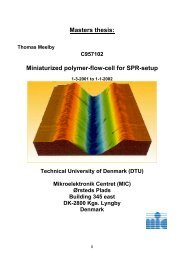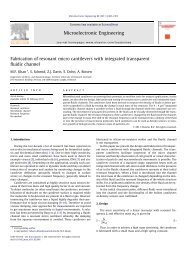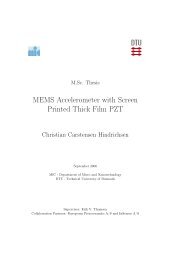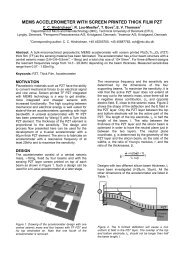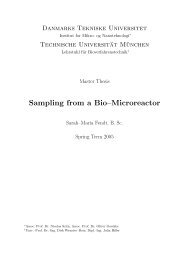Prototyping of microfluidic systems with integrated ... - DTU Nanotech
Prototyping of microfluidic systems with integrated ... - DTU Nanotech
Prototyping of microfluidic systems with integrated ... - DTU Nanotech
Create successful ePaper yourself
Turn your PDF publications into a flip-book with our unique Google optimized e-Paper software.
3.2 Polymer types 23<br />
• Compatibility <strong>with</strong> the biological chemical substances introduced<br />
in the system, so that the system is not affected by the substances<br />
or vice versa.<br />
• Good machinability by methods such as laser ablation (infrared,<br />
ultraviolet or X-ray) or micro milling, and applicable to mass<br />
replication methods.<br />
• Good optical properties, including transparency in the visible,<br />
infrared and ultraviolet parts <strong>of</strong> the electromagnetic spectrum, so<br />
that the system can be monitored from the outside. Also, the<br />
aut<strong>of</strong>luorescence <strong>of</strong> the polymer should be limited, so that the<br />
polymer does not interfere <strong>with</strong> the light used in measurements.<br />
• Surface modification options, so that the chemical and physical<br />
properties <strong>of</strong> the polymer can be tailored to match the needs <strong>of</strong><br />
specific processes and <strong>systems</strong>.<br />
The polymers used in micr<strong>of</strong>luidic today all posses several <strong>of</strong> the properties<br />
listed above, but differ in their characteristics, such as absorption<br />
spectrum and chemical resistance. A few <strong>of</strong> the most commonly used<br />
polymers are compared in section 3.4.2.<br />
Development <strong>of</strong> polymer types <strong>with</strong> specific properties, which are<br />
tailored for specific applications in micr<strong>of</strong>luidics is not common. Contrary<br />
to industrial scale production <strong>of</strong> macroscopic objects, the polymer<br />
quantities needed for making even millions <strong>of</strong> micr<strong>of</strong>luidic structures is<br />
in the order <strong>of</strong> a few tons. This is by no means enough for a manufacturer<br />
to cover development costs, so polymers <strong>with</strong> specific features and<br />
qualities are typically still initially produced <strong>with</strong> other applications in<br />
mind, and then at a later point introduced in µTAS and micr<strong>of</strong>luidics.<br />
3.2 Polymer types<br />
It is beyond the scope <strong>of</strong> this thesis to make a general introduction to<br />
polymers and to go into details <strong>with</strong> subjects such as polymerisation and<br />
polymer chemistry. The reader is referred to e.g. [20]. However, a few<br />
remarks on key concepts relevant for micr<strong>of</strong>luidic <strong>systems</strong> are presented<br />
in this section.



